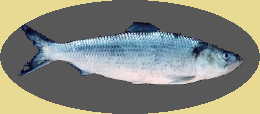

The Skipjack Herring is one of the primary baitfish that Striped Bass feed on in the Tennessee, Cumberland, and Ohio rivers in Western Kentucky from around the 4th of July thru September . Statement: I am just a fisherman, not a fisheries biologist, or scientist. The information here is what I have gathered from observations on the water, researching any and all books, magazines, and website's I could find. The information may not be 100% accurate but is only meant to give you a good understanding of this species of baitfish.
Nickames: tennesee tarpon, skipjack, river herring, herring.
Natural History: A migratory species, skipjacks assemble below dams in late spring returning from the gulf of Mexico or the lower Mississippi River. They spawn from late April to mid June, during which time they can be captured by dip net, cast net, jigs, spoons, or multi fly rigs.
Characteristics: Long and thin, bright silvery, blue-black back, protruding lower jaw and the presence of teeth in both jaws.
Typical Size: Adult length: 12-16 inches
Habitat: Prefer clear waters, normally found in swift current, over sand and gravel in large rivers.
Feeding Habits: Skipjacks eat plankton, minnows and larvae of mayflies and caddisflies. They feed in large schools, leaping out of the water while pursuing prey.
Fish Facts: Most every fish will feed on the skipjack herring until they reach the size of 5 inches at which time they become to large for most fish.
Bait: The herring are used whole and live for Striped Bass. Cut into chunks they make great catfish bait.
The skipjack herring is not usually consumed by humans because of its bony disposition, however a pleasure on the hook due to its speed, and jumping ability.
To catch the larger herring use lead head jigs with curly tails or spoons.